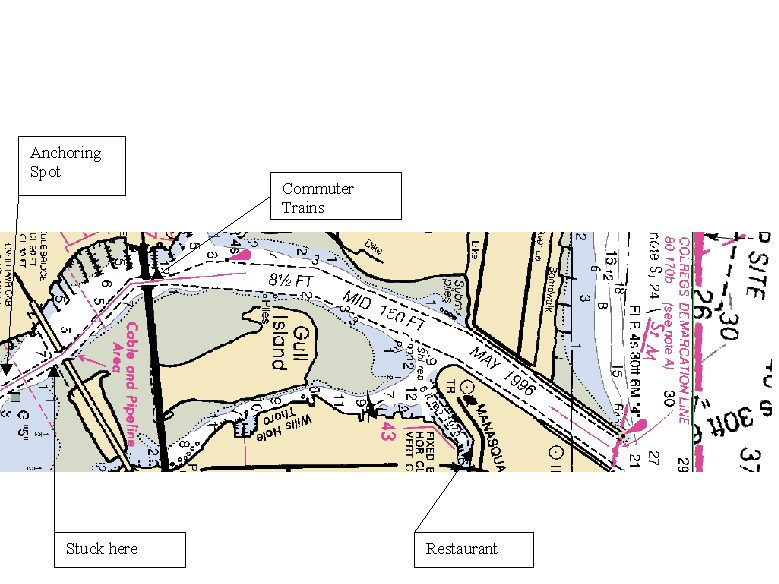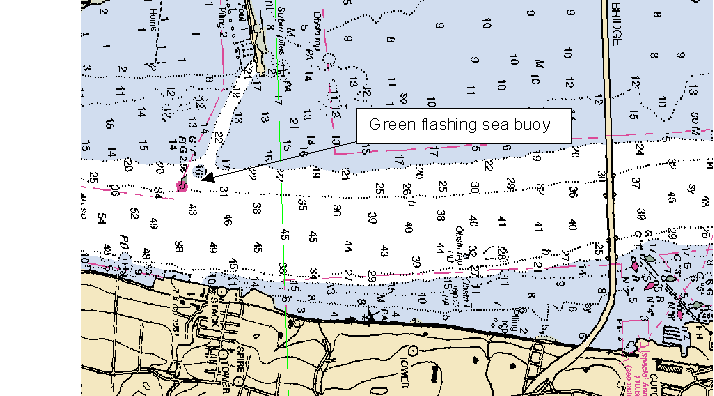
On May 23rd we started sailing up the Chesapeake Bay, stopping for fuel, pump out, and water in Annapolis MD. And anchoring every evening in a quiet cove and occasionally taking the dinghy in to enjoy a seafood restaurant.
Sailed down Delaware Bay next to large and fast Ocean freighters that warned me of large following wakes. The fastest freighter also told me that there was plenty of depth for me way outside the channel. He also told us to turn and face the wake he was leaving. We did and were glad of it.
May 27th we anchored in front of the Cape May Coast Guard Station on the southern end of New Jersey after entering the ICW through a very treacherous inlet with lots of cross current. Then on Sunday morning we went on the ocean proper and sailed up to the Atlantic City Inlet with three other sailboats. The first night we anchored in front of the Coast Guard station because Harrah's little marina wanted too much money and its dilapidated piers were exposed to lots of wave action. I was sound asleep in the center settee at 10:30 PM when a big gambler express, tourist boat came by and its wake threw me on the floor. Basically, I misunderstood the cruising guide's recommendation and did not realize that there was a quiet lagoon on the northeast side of the harbor across from the Coast Guard Station. The next day we snooped around at Trump's Marina after anchoring the mother ship in the quiet lagoon. At Trump's we still had to pay for the dinghy, but if we took a room it was free. We took a room for $55 and enjoyed one good nights sleep as well as internet access while the wind kept on howling. We stayed in Atlantic City for three nights until the high winds subsided.
Next stop was for two nights, June 7 and 8, at the Spray Beach Yacht Club next to the Mariner 36, Fandango, courtesy of Peter & Carolyn Vehslage. Peter's parents have a home on this thin sliver of land only a few yards away from the roaring ocean. The next day Peter's parents took us for a trip up the thin barrier reef to tour the Barnegat Lighthouse.
We stayed on the inside from Atlantic City up to Manasquan Inlet. Just before arriving at the Manasquan Inlet I had some scary moments. Shortly after entering Point Pleaseant Canal, with its 4 knot current and rapids, we rounded a bend and found a closed lift bridge only 200 yards away. The bridge operator was chastising me for God only knows what as I cranked the wheel completely to the left and made the 180 degree turn in the very narrow channel right in front of several oncoming cabin cruiser. Fortunately I had the sails down and the engine was working flawlessly. I must have been pretty flustered because an hour later we came to another bridge that only opened every hour and had a 58 minute wait as they closed the bridge when we were only 2 minutes away. So we anchored just upstream (tide going out), and when they raised it we pulled up anchor and started going toward the bridge. We ended up getting to the bridge before it was sufficiently open so we tried to turn around but the channel was too narrow and we hung the boat up on a sand bar. After about 2 minutes the bridge tender asked if we were grounded, and proceeded to lower the bridge again. We wiggled and squiggled the boat forwards and backwards for 25 minutes before it finally broke free of the sand bar. We humbly, went back to our upstream anchoring spot to wait for another chance at the bridge opening. This time waited until the bridge was fully open before we got anywhere close to it. The next bridge (a railroad bridge that closes right after a loud horn blast whenever a train is approaching) blasted its horn, closed, and stayed closed while commuter trains passed by every ten minutes or so for the next hour. You can see that going on the inside has its perils and tribulations as well as going on the ocean proper.

At Manasquan Inlet we tied to a restaurant's dock for twenty bucks. Later they gave us a twenty buck discount on our our meal at the restaurant. Here we meet Dan and Shirley aboard the Mariah from Green Bay. They had just returned from the Bahamas. We saw their boat once more on the Chambly Canal just above the Chambly Basin and the Riviere Richelieu in Canada, but never in Green Bay. The next morning we went back on the ocean proper in a nice breeze out of the northwest that allowed us to sail close hauled along the coast to Sandy Hook just south of New York City.
Seeing the Statue of Liberty from the boat made me view it as immigrants must have when they came to these shores. We sailed into the Hudson River, and were so stunned by New York's skyline that we forgot to buy fuel. We think we ran out in the middle of the Hudson River just as the sun set and had to use our insurance to have TowBoats US come to our rescue. Markus's calculations indicated we still had 5 gallons of diesel fuel, and even after adding the seven gallons brought out to us by TowBoats US it took a full forty five minutes to get the engine primed and running. In the process we ended up loosening an injector input line, spilling while pouring fuel into both the primary and secondary filter canisters, loosening other lines to purge out air. This left a smelly mess in the engine room that we just hate. Mark stayed below and washed up everything with laundry detergent till the smell was all gone. Later the smell came back as one of the injector lines was not tightened all the way. Judy started steering just five minutes away from a very large, twelve foot diameter, twenty foot tall, lighted, green sea buoy about two miles south of the Tappan Zee Bridge. Mark pointed out the lighted sea buoy and told Judy to take it on the port side. Five minutes later, while Mark was below cleaning up the mess, there was a blood curdling scream as Judy discovered that the current was slowly sweeping Sankaty right up against the sea buoy. Mark jumped out of the cabin and grabbed the wheel to try and rotate the boat around the sea buoy (We should have given Sankaty the full throttle.). Anyway we did sustain a dent in the aft portion of the rub rail; and the decorative trim, over the toe rail needs a three-foot section replaced. We are discovering that Judy has poor night vision and that current has a significant impact on trajectories when going too slow. Next time we will simply anchor the boat until we have our act together. The advanced navigation course teaches about current and drift. Maybe next time we'll take that also.

Mark now suspects that the secondary fuel filter became clogged as we did have the engine stop abruptly one more time a month later. That time the tank was full so we looked for other problems and found that the secondary inlet line was under tremendous pressure and changing the secondary filter solved the problem instantly. That is after we primed and purged the air from the lines. Here we learned that it is prudent to have a quart of clean diesel in a separate container. Mark ended up siphoning up some fuel, but got a tongue full too.
June 4th we stopped in at the Haverstraw Marina to say Hi to the people we met while evaluating the Gulfstar 42. We met Dan Sheehan who did the survey for us and showed us the value of a portable booster battery. We also talked with Barb Samalot who helped us make the initial offer on the Gulfstar 42.
June 5th we anchored at a niffty spot next to an abandoned castle on Pollepel's Island a five miles north of West Point. This is a very picturesque area that we got to know quiet well only 11 months earlier, while staying at the Croton-on-Hudson campground during our making offers and paying for survey's phase.
On June 6th we arrived in Castleton-on-Hudson and the next day we just stayed in the boat at anchor on the west side of the river while it rained and rained and rained all night and all day.